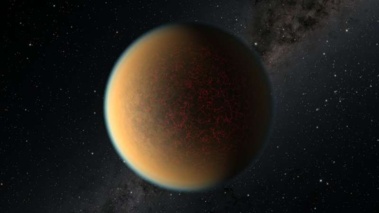Earth-sized exoplanet may have lost its original atmosphere, but gained a second one through volcanism

rbiting a red dwarf star 41 light-years away is an Earth-sized, rocky exoplanet called GJ 1132 b. In some ways, GJ 1132 b has intriguing parallels to Earth, but in other ways it is very different. One of the differences is that its smoggy, hazy atmosphere contains a toxic mix of hydrogen, methane and hydrogen cyanide. Scientists using NASA's Hubble Space Telescope have found evidence this is not the planet's original atmosphere, and that the first one was blasted away by blistering radiation from GJ 1132 b's nearby parent star. The so-called "secondary atmosphere" is thought to be formed as molten lava beneath the planet's surface continually oozes up through volcanic fissures. Gases seeping through these cracks seem to be constantly replenishing the atmosphere, which would otherwise also be stripped away by the star. This is the first time a secondary atmosphere has been detected on a world outside our solar system.
Scientists using NASA's Hubble Space Telescope have found evidence that a planet orbiting a distant star may have lost its atmosphere but gained a second one through volcanic activity.
The planet, GJ 1132 b, is hypothesized to have begun as a gaseous world with a thick hydrogen blanket of atmosphere. Starting out at several times the diameter of Earth, this so-called "sub-Neptune" is believed to have quickly lost its primordial hydrogen and helium atmosphere due to the intense radiation of the hot, young star it orbits. In a short period of time, such a planet would be stripped down to a bare core about the size of Earth. That's when things got interesting.
To the surprise of astronomers, Hubble observed an atmosphere which, according to their theory, is a "secondary atmosphere" that is present now. Based on a combination of direct observational evidence and inference through computer modeling, the team reports that the atmosphere consists of molecular hydrogen, hydrogen cyanide, methane and also contains an aerosol haze. Modeling suggests the aerosol haze is based on photochemically produced hydrocarbons, similar to smog on Earth.
Scientists interpret the current atmospheric hydrogen in GJ 1132 b as hydrogen from the original atmosphere which was absorbed into the planet's molten magma mantle and is now being slowly released through volcanic processes to form a new atmosphere. The atmosphere we see today is believed to be continually replenished to balance the hydrogen escaping into space.
"It's super exciting because we believe the atmosphere that we see now was regenerated, so it could be a secondary atmosphere," said study co-author Raissa Estrela of NASA's Jet Propulsion Laboratory (JPL) in Southern California. "We first thought that these highly irradiated planets could be pretty boring because we believed that they lost their atmospheres. But we looked at existing observations of this planet with Hubble and said, 'Oh no, there is an atmosphere there.'"


Your Comment :